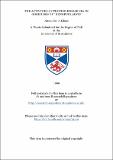Files in this item
The activities of protein kinase CK2 in oogenesis of `Xenopus laevis'
Item metadata
| dc.contributor.advisor | Sommerville, John | |
| dc.contributor.author | Llinas, Alexander J. | |
| dc.coverage.spatial | 240 p. | en_US |
| dc.date.accessioned | 2018-06-25T08:51:16Z | |
| dc.date.available | 2018-06-25T08:51:16Z | |
| dc.date.issued | 1999 | |
| dc.identifier.uri | https://hdl.handle.net/10023/14510 | |
| dc.description.abstract | Protein kinases play important roles in regulating cellular functions in many organisms. This work deals specifically with the protein kinase CK2 (casein kinase II) and its role in regulating the activity of proteins involved in oocyte development in Xenopus laevis. Protein kinase CK2 is a tetrameric enzyme containing two catalytic subunits (alpha and alpha') and two identical regulatory subunits (beta) which forms the holoenzyme. CK2 phosphorylates many different proteins involved in many aspects of cellular functions. It phosphorylates serine and threonine sites and is considered to be a ubiquitous enzyme, expressed at different levels in different cell types. In this study CK2 activity was characterized in material from two sources: from isolated nuclei and messenger ribonucleoprotein (mRNP) particles from Xenopus oocytes. cDNAs expressing both the alpha and the beta subunits were cloned and antibodies were raised against the fusion protein containing the beta-subunit. The main objective of this study was to determine the effects that CK2 had on proteins involved in oocyte development. The interaction of CK2 with a protein known as histone deacetylase was studied in depth to determine how phosphorylation might influence its function and cellular compartmentalisation. Specifically, phosphorylation by CK2 is shown to improve the kinetics of nuclear unport, and the interaction of histone deacetylase with alpha-importin, a well-established nuclear transport protein, is revealed to be dependent on the phosphorylation state of histone deacetylase. Another aspect of this work is related to the association of CK2 with mRNP particles in the cytoplasm. mRNP particles function as long term storage units for mRNA to be used during oocyte maturation and early embryogenesis. It has been postulated that a protein kinase associated with these particles plays a role in controlling the binding of mRNA to proteins involved in translation repression (mRNA masking proteins). This study lends support to that theory, and the possible effects of CK2 phosphorylation on the masking "Y-box" proteins are discussed. | en_US |
| dc.language.iso | en | en_US |
| dc.publisher | University of St Andrews | |
| dc.subject.lcc | QP552.K5L5 | |
| dc.subject.lcsh | Kinins | en |
| dc.title | The activities of protein kinase CK2 in oogenesis of `Xenopus laevis' | en_US |
| dc.type | Thesis | en_US |
| dc.type.qualificationlevel | Doctoral | en_US |
| dc.type.qualificationname | PhD Doctor of Philosophy | en_US |
| dc.publisher.institution | The University of St Andrews | en_US |
This item appears in the following Collection(s)
Items in the St Andrews Research Repository are protected by copyright, with all rights reserved, unless otherwise indicated.

